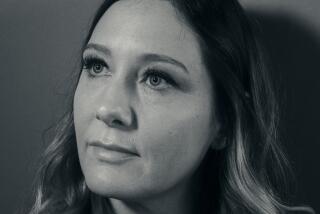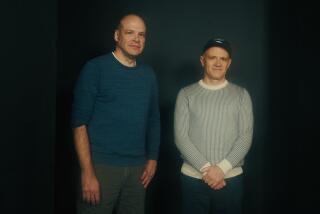The Brothers Quay Make a New Move Through the Dark
Animation aficionados tend to speak of the work of the brothers Quay in reverential tones. Identical twins born in Philadelphia and based in London since 1979, they’ve completed 14 darkly enchanting stop-action films that shimmer with a mood of gothic surrealism all their own.
Eight of these miniature masterworks will screen tonight at the Nuart Theatre; to be up to speed with the Quays, however, you must return to the Nuart Thursday night for the L.A. premiere of “Institute Benjamenta.”
The Quays’ first live-action feature, “Institute Benjamenta” chronicles the disintegration of a creepy school for servants where the students are required to endlessly repeat a single task. Based on “Jakob von Gunten,” a novella written in 1908 by Swiss writer Robert Walser, the film stars Alice Krige and Mark Rylance, and, incredibly enough, has all the eerie magic of the Quays’ animation.
In Los Angeles briefly to cast a commercial--”we periodically do those to pay the rent on the studio,” they say--the brothers begin by explaining that it’s best to quote them as a unit rather than as Timothy or Stephen. Because it’s virtually impossible to tell the inseparable 47-year-old brothers apart, that seems reasonable.
“ ‘Jakob von Gunten’ is sort of a retelling of the Sleeping Beauty fable,” they say of Walser’s novel, which was translated into English and published in the United States in 1970. “In this telling, however, the prince arrives with the kiss of death, rather than the kiss of life, and the story revolves around four characters: Jakob, who represents the prince; the instructress Lisa who is the lyrical underbelly of the film; her brother, Herr Benjamenta, who is the ogre; and the student Kraus, who aspires to be absolutely nothing and is attempting to reduce himself to the perfect zero.”
As might be deduced from this darkly humorous scenario, Walser had a difficult life. His early years were spent writing prolifically, getting very little published and drifting from job to job. In 1929, after a period of intense isolation and poverty during which he suffered from hallucinations and nightmares and made several suicide attempts, he committed himself to a Swiss sanatorium where he was found to be schizophrenic. His writing came to an abrupt halt four years later, and he spent his remaining 23 years going for walks in the hills surrounding the hospital.
“Walser never married and the evidence suggests he never had a sexual experience,” the Quays say. “There’s something incredibly chaste in his writing, something refined and vaporous that we find very moving. His work is also marked by an obsession with subtle detail, which makes it well suited to our needs.”
Chaste though Walser’s writing is, it fairly pulsates with repressed sexuality, and “Institute Benjamenta,” too, is riddled with images that beg for Freudian interpretation. The Quays insist that none of this is intentional. “We’re not good at that sort of thing,” they say. “We think in images, but we never try to dismantle and analyze them.”
*
Rather, one of the key things that drew them to Walser’s work was its scale.
“We knew that if we were to do a feature it would have to be a chamber work because we’d never get the budget to do anything big,” they say. “We knew the story would have to unfold within a confined space where we could have full control, and as we expected, there wasn’t a big budget--we were given $1.5 million to make the film. But of course, even if we had unlimited funds we wouldn’t work any differently, because we wouldn’t know how.”
Indeed, the Quays come as close as seems humanly possible to creating hand-made films. Trained as illustrators, they made the puppets and sets in all their previous films, wrote the scripts, designed the lighting and worked closely with Polish composer Lech Jankowski in shaping the music. This tactile experience is put to work in “Institute Benjamenta” in surprising ways.
“Animation makes you acutely aware of the ways in which space is created and manipulated, and one thing we wanted to attempt in this film was to imbue a place with the presence of major characters,” they say. “The institute has a quality of contamination and it leaves a stain on everyone who inhabits it. Similarly, objects--forks, antlers, a goldfish bowl--are given equal weight to the characters, and that too is a result of having worked in animation.”
The Quays are quick to point out that their creative sensibility was largely shaped by the music, art and literature of Eastern Europe. One wonders how they got there from their working-class beginnings in Pennsylvania, where their father worked as a machinist and their mother devoted herself to homemaking.
“We were boring children--prior to going to art school we were basically basket cases,” they say and laugh. “Philadelphia was a decrepit, clamped-down city, and it wasn’t until we enrolled in art school there that things started to open up for us.
“The first day we walked into the Philadelphia College of Art we came upon an exhibition of Polish posters from the ‘60s that completely galvanized us. They were models of utter simplicity--just the most graphic images with a few bristling words in Polish referring to people we’d never heard of. We started searching for them in libraries and that’s how we found Bruno Schulz, Robert Walser, Franz Kafka, Jan Svankmajer--all the people we love.
“Part of what attracted us was the fact that this is a region where animation has always been treated as a form for adults as well as children,” add the Quays, who completed their education at the Royal College of Art in London from 1969 to 1972. “Because it was a form the authorities dismissed as trivial, artists turned to it as a place where subversive ideas could be smuggled through.
“One rarely sees this sort of thing in America, because Disney’s had a stranglehold on animation in this country for a long time,” say the brothers, who completed their first film, “Nocturna Artificialia,” in 1979, with a grant from the British Film Institute. “One can’t just blame Disney though, as the American ethic is grounded in a reluctance to look at the dark side. Things are cleaned up and sanitized here, and we make sure kids don’t run into anything remotely unsavory.”
Though the Quays don’t retreat from things unsavory, it’s never their intention to court the lower emotions.
“There are moments of grace in life, fragile, beautiful moments which go into eclipse, and that’s what we search for,” the Quays say. They recently completed a script for a second feature, which they describe as an homage to several South American writers they admire. “We’re always looking for the things on the edges obscured by shadows, and we try to drag those things a bit more into the light, lest they disappear.”
More to Read
Only good movies
Get the Indie Focus newsletter, Mark Olsen's weekly guide to the world of cinema.
You may occasionally receive promotional content from the Los Angeles Times.










